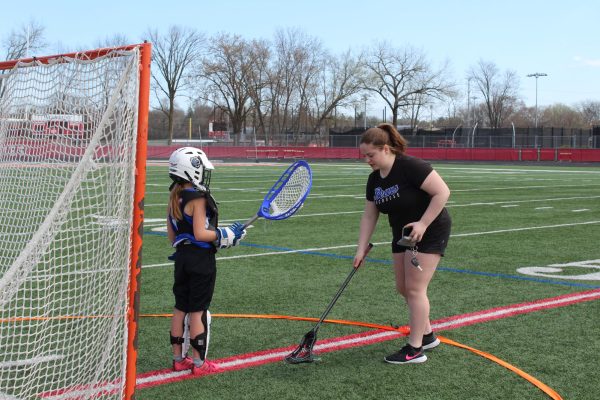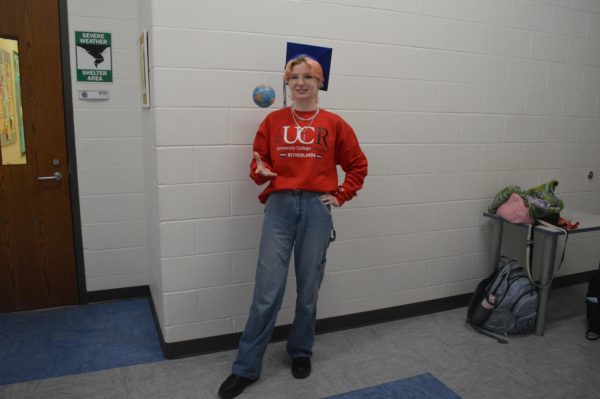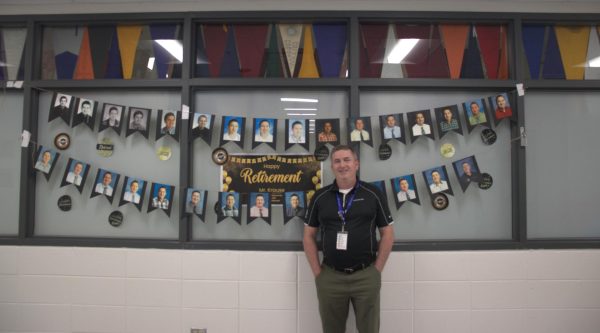Extinguishing a world on fire
Climate change sparks need for solutions
As the human population continues to grow exponentially, it faces the challenge of using Earth’s finite resources sustainably.
The Intergovernmental Panel on Climate Change (IPCC), a United Nations body that releases a rigorously peer-reviewed climate report every few years, stated that “it is unequivocal that human influence has warmed the atmosphere, ocean, and land,” in their 2021 Summary for Policymakers.
However, according to the Pew Research Center, there are “wide partisan divides” on the question of how the federal government should be handling climate change. Between science and politics, many students are trying to stay informed and involved, advocating for solutions to mitigate current climate change effects and preserve a clean and livable planet for future generations.
A Cause For Concern
The American Psychological Association describes eco-anxiety as a chronic fear of environmental disaster, stemming from a panic over potentially irreversible impacts of climate change and how future generations will be affected. While it may not be so extreme for everyone, for many, including the 37.1% of LZHS students who say they’re very concerned over the issue of climate change, humanity’s impact on the environment brings worry.
“[Sohan and I] are very concerned with the direction that the environment is heading,” Rohan Vuppala, co-founder of the EDvironment Club, said. “I think it all started after taking our AP Environmental Science class. We realized that the current state of the environment was heading in a more negative direction.”
Signs of climate change can be seen on a worldwide level, but they are easy to observe in the LZ community too, according to Julie Gyarmaty, Environmental Science teacher.
“We don’t have ice covers for as long because we have more warm days. It doesn’t get as cold in December as it used to. The cold season doesn’t last as long as it used to when I was younger. I see signs of trees that are in distress, and I see that the coniferous trees are not doing as well in this area as they used to, they’re moving more north. Different types of plants that used to grow well here don’t grow [as] well [anymore]. I see all the drought that happens. They last longer,” Gyarmaty said.
Despite these tangible observations of climate change, evidence shows that 18% of Americans are now dismissive or doubtful about the science behind climate change, according to GRIST, a non-profit online magazine that publishes environmental news and commentary. Gyarmaty credits this to people being engrossed in problems of their own and not being able to see the state of the climate.
“I think people get caught up in their own personal things they have going on in their lives. They don’t see [climate change] as an issue that’s really affecting them on a big level at the moment,” Gyarmaty said.
The disengagement that Gyarmaty describes may also be present in LZHS. 92.7% of students say they believe the climate is changing, but only 37.5% of students say they or their families make personal choices to combat climate change.
However, on a national level, there is a rising share of U.S. citizens claiming that climate change should be a top priority for the President and Congress, according to a January 2020 survey conducted by the Pew Research Center. Among these concerned citizens, there was a higher concentration of Democrats, with Lucas McMahon, sophomore, being one of them. He says his brother’s political beliefs motivated him to start looking into the issue on his own.
“My brother, who’s definitely liberal, or more to the left, brought up the issue [of climate change]. He was telling me […] there’s so much science behind it,” McMahon said. “That’s when I started looking into it, concerning myself. Then all of a sudden, I [started] seeing what climate change [was] doing.”
McMahon says his biggest fear comes from how big corporations disproportionately contribute to climate change and have significant influences on environmental legislation through lobbying.
“[Monopolies] are buying up lobbying spots for politicians. Politicians aren’t going to help you because they’re getting money for their next campaign [from] these big monopolies,” McMahon said. “Climate change and other environmental issues are just being increased by these companies.”
Every year, the world’s five largest publicly owned oil and gas companies (BP, Shell, ExxonMobil, Chevron, and Total) collectively spend approximately $200 million on lobbying designed to control, delay, or block binding climate-motivated policy, according to Forbes.
Although Rudy Tabachnik, senior, isn’t as concerned about climate change as McMahon, he has also noticed that policymakers may not have the public’s best interests in mind. Tabachnik says, regarding rising gas prices, politicians say, “it’s Putin’s tax, just go buy an electric vehicle. Just do all these things. It’s the equivalent of Mary Antoinette saying, ‘Let them eat cake.’ They don’t care for the average person. What they do care about is their bottom dollar. […] It’s using climate change as a buzzword.”
However, Gyarmaty says that if legislation that helps mitigate climate change cannot be enacted, there will be significant impacts on people’s jobs, health, and lifestyles. According to Sohan Vuppala, co-founder of the EDvironment club, there is a limited amount of time to combat these risks, and these threats demand urgent action.
Permanent health impacts aren’t an unlikely scenario. To avoid catastrophic health impacts like the millions of climate change-related deaths that are predicted, the world must limit temperature rise to 2.7°F, according to the Intergovernmental Panel on Climate Change (IPCC). If the atmosphere keeps heating up at the rate it is, the world is predicted to reach this warning limit in the early 2030s. This means that a child born today will face a world that is on average 7.2°F warmer by their 71st birthday, putting their health under threat at every stage of their lives.
“Future generations of people that are going to be on this planet, if we don’t do stuff now, [are] going to be left with a heavier burden,” McMahon said. “We should be worried. They might not even get the chance to live.”
Be Informed
There are a variety of ways for students to be informed about environmental issues, such as taking a class like AP Environmental Science, joining an environmental organization or club, and researching through books, articles, documentaries, and the Internet.
With a variety of resources available at students’ fingertips, Gyarmaty stresses the importance of students staying informed to stay involved.
“[Students] just need to take the time to read and they need to take the time to write to their legislators,” Gyarmaty said.
The Vuppala brothers believe that being informed is so important that their club, EDvironment, is dedicated to passing state legislation that would require a day of environmental learning in Illinois schools, which Rohan says he has heard will be implemented in District 95 within this semester.
“We thought legislative action was one of the main ways to be able to integrate environmental education into people’s lives,” Rohan said. “We talked with a representative from the state of Illinois, who then directed us to Representative Chris Bos, who recommended that we try and integrate as many schools as we can on this environmental education day and implement it in our own school as well.”
EDvironment intends to localize awareness of large-scale problems through education.
“[Rohan and I] believe by giving people this knowledge, hopefully it’ll inspire them to take more action in helping the environment,” Sohan said.
When McMahon learned about the climate crisis, he began reading and watching videos about how climate change impacts natural disasters and the food supply. He says he learns about climate change “on YouTube. I’m subscribed to […] the New York Times, CNBC, Vox, and a couple others; news sources that publish things on climate change, and publish what’s happening because of climate change.”
Staying informed can make it difficult to ignore the problem, which Cristina Mac Cormac, junior, says is necessary to motivate people to act.
“A lot of people are scared to admit something like this is happening,” Mac Cormac said. It’s much easier to pretend climate change isn’t occurring or it’s not your problem to deal with, rather than seeing the issue at hand and doing your part […] to help the matter.
Call To Action
Students’ concern for the environment can inspire them to take action and find solutions. Environmental involvement can range from small lifestyle changes to even more meaningful commitments.
Making sure that people are “not just recycling, but mindful recycling” is something Sohan says is important. While people may be recycling, they “don’t actually know what they’re supposed to be recycling and sorting,” and plastics misplaced by recyclers with good intentions have long term implications, as they take hundreds of years to decompose and harm the environment.
Everyday contribution to environmental issues can also take place in the lunchroom through food waste, according to Rohan.
Approximately 133 billion pounds and $161 billion worth of food was sent to landfills in 2010, according to the U.S. Department of Agriculture. This food generates methane, a potent greenhouse gas which contributes to global warming.
“The next time you’re thinking of just leaving out half of your food and throwing it out to waste, you could think, ‘Oh, maybe I should compost this instead,’ or ‘maybe I can save it as leftovers and turn it into some other dish that I would eat later,’” Sohan said. “It’s little actions that I feel like people can do.”
Reducing food waste, taking public transportation, or carpooling are ways students can be more environmentally conscious, Rohan says. McMahon agrees that everyone’s decisions have a part to play in environmentalism. In his own life, he says he tries to be conscious of shutting off lights when he’s not using them. He also tries to support companies that have greener outlooks and are investing in renewable energy and sustainable packaging.
“As consumers, you have the choice between something wrapped in plastic, or something manufactured using fossil fuels and something manufactured using green energy. Even if the green energy is higher in price, if you have that choice, you should exercise that choice,” McMahon said. “That’s your responsibility as a good consumer because in the end, you need to support the products that are going to help lessen our carbon footprint and help lower pollution.”
But environmental action isn’t limited to the changes individual students make in their own lives; it also extends to legislative and corporate powers.
“I hope governments start subsidizing more intensively for renewable energies. I’m going to be honest, they don’t do enough of it. If we’re ever going to change anything, they’re going to have to get some work done,” McMahon said. He suggests joining lobbying efforts to advocate for renewable energy subsidies and climate legislation.
To begin personal involvement in governmental change, McMahon says that electing people that have lobbyists that don’t fight against climate policies is important, and it starts with being educated on what environmental issues are happening.
A good starting point for students looking to get involved in environmental issues, according to Mac Cormac, is researching different issues and finding out what interests them most.
“The main two things I do to stay involved is be a part of the school’s REACT club, and I’m a member of Citizens’ Climate Lobby,” Mac Cormac said. “At CCL, the organization and I lobby, or meet, with Congressmen about adding more climate change legislation into government. For example, I’ll be traveling to D.C. this summer for a national [CCL] climate conference. Being a part of CCL is my way of contributing to help climate change at a much broader level, and then I can do that more locally through REACT club at school.”
While influencing legislation may seem difficult to initiate, Rohan says it’s helpful for people to begin being environmentally conscious in any way they can.
“I feel like people get this misconception that they have to do this big act or they have to join a huge group or something so that they can show that they’re being environmentally conscious, otherwise they’re not really caring about the environment,” Rohan said. He says that doing something, even if it’s just being more conscious in your decisions, is better than nothing, and will help contribute to a more sustainable future.
Environmental Justice
Environmental justice is the fair treatment and meaningful involvement of all people regardless of race, color, national origin, or income, with respect to the development, implementation, and enforcement of environmental laws, regulations, and policies.
— Environmental Protection Agency Website
Environmental issues do not impact all people equally. Many people, such as activists and legislators, advocate for those most impacted by environmental problems on a grassroots level, while for others, environmental justice and sustainability play important roles in their careers.
One LZHS 2012 graduate, Kaitlyn Etienne, currently works in supply-chain sustainability at a health care company. Etienne learned how the environment impacts people when she took her first environmental studies classes for her undergraduate degree.
She learned “about how climate change is and is predicted to continue impacting communities differently, not just around the world, but also dependent on means and access to things like water, or the ability to move if your home floods, or the ability to recover from economic loss due to a natural disaster like a wildfire or a hurricane,” Etienne said. “And climate change is something that we all contribute to, no matter where we live.”
A country where the average person’s carbon footprint is higher might see fewer effects in the short term from climate change than someone living in a country where the average person’s carbon footprint is lower, Etienne says.
“That’s where the disparity comes into play,” Etienne said. “Because you’re not putting as much carbon out, but you’re seeing the effects sooner, or they’re hitting you more strongly. For example, you live on an island in the Pacific that’s going underwater; [that’s] definitely a country where each individual’s carbon footprint is way smaller than the average individual’s carbon footprint in the US.”
A recent example of this is when Chicago denied a General Iron scrap shredder a permit to relocate from the more affluent North side to the less affluent Southeast side of the city, citing the facility’s “long history of pollution problems,” according to the Chicago Tribune.
Situations like this are a large part of an environmental attorney like Molly Snittjer’s job. Snittjer works for a Chicago-based law firm that specializes in “environmental litigation defense and enforcement,” according to its website.
Environmental justice “impacts the facilities that we represent and how they interact with the communities around them,” Snittjer said.
One of the biggest concerns, according to Snittjer, is considering the cumulative impact of putting many facilities in one area. Many companies want to build facilities in the South side or the West side of Chicago, because “it’s cheaper, and typically the communities have not objected as strongly,” Snittjer said, adding that “there’s also some concerns in Waukegan.”
To aid areas that have been labeled as “environmental justice communities,” Snittjer stresses the importance of public participation and of government agencies considering the community’s input and making environmental justice a part of the conversation.
“Typically, no one’s just perusing the Illinois EPA website, or looking critically at those permits,” Snittjer said. To get people involved, she says it’s important to “[make] sure that [people living in environmental justice communities] have, first of all, access to know what’s going on, and then second of all, they have the ability to interpret what that means for their community.”
Although Snittjer says it’s important for those who don’t live in environmental justice communities to know where those areas are and how they are being impacted, it’s most important that the community itself is well-informed and involved.
“You don’t want someone that doesn’t live in that community to be the savior for that community or making decisions on behalf of the community that they don’t live in,” Snittjer said. “Everything is supposed to be a little more grassroots-driven, and making sure that it’s the voice of the community that’s being heard.”
Etienne suggests reading books, watching documentaries, and joining a national group like Citizens’ Climate Lobby to learn about how socioeconomic status and race influences people’s environment disproportionately.
“The carbon footprint of an individual is only so big,” Etienne said. Therefore, she says by learning about what policies are being proposed even before being old enough to vote, people can support climate justice and policies that reduce the carbon footprint of the country as a whole when they are of voting age.
“Learning about connections between carbon and waste, carbon and transportation, carbon and food, carbon and the products that we purchase, I think that’s definitely something that’s applicable to Lake Zurich,” Etienne said, “because it’s applicable anywhere.”

Hannah’s third year on staff is her first year as Spotlight Editor. She spends more time talking to her cats than practicing her flute as a band member....

Coming back for her last year on Bear Facts, Gurneer will be Spotlight Editor for the second year in a row. Outside of Bear Facts, she participates in...

Going into their third year of being on the Bear Facts Staff, Kara hopes to take on Lois Lane-type capers as a senior. If you were to spot them outside...

Going into her sophomore year, Kyra Keena is eager to start her first year as Live Media Manager, and second year in the journalism program! When she isn’t...










